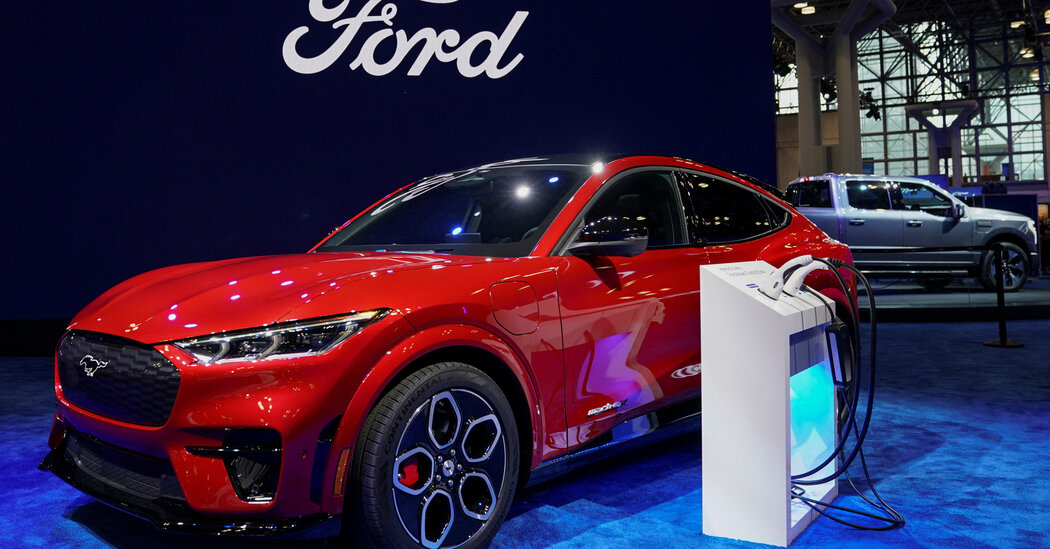
U.S. Car Brands Will Benefit Most From Electric Car Tax Breaks
American brands like Tesla and General Motors will benefit most from rules that determine which electric vehicles qualify for tax credits starting on Tuesday. Foreign carmakers like Hyundai will be at a significant disadvantage because of restrictions aimed at cutting China out of the supply chain.
Only 10 vehicles will initially qualify for tax credits of $7,500, less than a quarter of the battery-powered cars on sale in the United States. But those 10 include many of the most popular models and accounted for two-thirds of electric vehicle sales before the new rules took effect.
Tesla Model 3 and Model Y models, the best selling electric vehicles in the United States, will qualify for the full $7,500 credit, with one exception, according to a list published by the Treasury Department on Monday. The least expensive version of the Model 3 will qualify for only half the credit because its battery is made in China.
G.M.’s Chevrolet Bolt, one of the cheapest electric vehicles on the market, will also qualify, as will sport utility vehicles and pickups that the company plans to begin selling this year.
Fewer Ford vehicles will qualify for the full $7,500 credit because of rules requiring that a certain percentage of the battery components and minerals like lithium either come from domestic sources or trade allies. Ford’s Mustang Mach-E, the third best-selling electric vehicle in the United States last year, according to Kelley Blue Book, will be eligible for only half the credit because its Polish-made battery does not meet domestic sourcing requirements. The F-150 Lightning pickup will continue to qualify for the full credit.
Chrysler and Jeep, divisions of Stellantis, do not yet sell cars that run solely on batteries but several of their hybrid models will qualify for at least some of the credit. Hybrid vehicles can qualify if their batteries have a capacity of at least seven kilowatt-hours.
The rules give U.S. carmakers at least a temporary advantage over competitors like Toyota, Volkswagen and Nissan. No foreign automakers were on the Treasury list, which is expected to grow as companies adjust their supply chains.
The Rise of Electric Vehicles
- Electric Vehicles: Government scientists have spent a year analyzing electric vehicles to help the E.P.A. design new rules aimed at speeding up an electric car revolution. But meeting the new targets will be a challenge for automakers.
- A Case Study: Ohio, a state that is heavily dependent on the auto industry, is a bellwether of how the transition to electric vehicles could play out across America.
- Retiring the Camaro: General Motors is ending production of the classic American sports car, but executives say an electric version is likely.
- Lithium Prices: A decline in the price of the essential battery material, along with those of other commodities, is making electric cars more affordable. But experts disagree on how long it will last.
Carmakers who qualify for the tax credits now will have a head start as sales of electric vehicles take off. “It causes a multiplier effect in the market,” Paul Jacobson, G.M.’s chief financial officer, told reporters in New York this month. The rules, he added, are “very consistent with the strategy that we had already adopted.”
The rules grow out of the Inflation Reduction Act, which Democrats passed last year to fight climate change and encourage domestic manufacturing among other things. The Treasury Department was responsible for writing regulations based on the legislation.
The law seeks to reduce the auto industry’s reliance on China, which makes most of the world’s batteries and dominates the processing of raw materials. The law also establishes limits on sales prices and excludes individuals who earn more than $150,000 a year and couples who make more than $300,000. The rules also exclude vehicles made outside North America, including in allied countries like South Korea and Germany.
“We were not happy,” José Muñoz, the chief executive of Hyundai and Genesis Motor North America, said in an interview at the New York International Auto Show this month. Hyundai’s Ioniq 6 electric sedan was named World Car of the Year at the show, but will not be eligible for tax credits because it is assembled in Korea.
Hyundai, based in Seoul, is investing $10 billion to build car and battery plants in Georgia, which will allow the company to meet the Inflation Reduction Act requirements — but not for several years.
Officials at the carmaker and the Korean government asked the Biden administration to allow Hyundai and Kia cars to qualify for credits while the factories are under construction, but were told the law did not allow such an exception, Mr. Muñoz said.
The Hyundai car factory in Georgia is expected to begin producing cars in 2025. The battery plant, which Hyundai is building with SK On, will start production in 2026. “We are working on putting ahead that date so we can qualify earlier,” Mr. Muñoz said.
Tesla had already told potential buyers that the least expensive version of the Model 3 sedan would qualify for only half the credit, or $3,750. This month, Tesla cut the price of that car by $1,000 to $41,990. After accounting for the partial credit, the car will effectively cost many buyers a little more than $38,000, about as much as a top of the line Honda Accord and cheaper than an entry-level BMW 3 series sedan.
Other versions of the Model 3 and Model Y S.U.V. will continue to receive the full credit. Tesla sold more electric vehicles in the United States last year than all other carmakers combined, according to Kelley Blue Book.
Some auto executives have said the rules are too restrictive and undermine efforts to limit climate change. Other critics like Senator Joe Manchin III, Democrat of West Virginia, have complained that the Biden administration’s rules are too lenient.
Administration officials have argued that the regulations strike a balance between promoting electric vehicles and building a domestic supply chain.
By the administration’s count, besides the 10 vehicles that qualify for the full credit, seven qualify for half the credit. Vehicles can qualify for half the credit if, for example, their battery components come from the United States, Canada or Mexico but the minerals used to make the batteries do not meet the sourcing requirements.
Ten vehicles that previously qualified, including the Nissan Leaf and the Volkswagen ID.4, will drop off the list, at least temporarily.
The Volkswagen ID.4, an S.U.V. made in Chattanooga, Tenn., did not make the list issued by the Treasury Department on Monday because it is still assessing its supply chain. But Pablo Di Si, the chief executive of Volkswagen Group of America, said he expected the model to qualify. Volkswagen was fourth behind Tesla, G.M. and Ford in U.S. electric vehicle sales in the first three months of the year, according to Kelley Blue Book.
Five electric vehicles that G.M. sells or is planning to sell this year will qualify. In addition to the Bolt, the Cadillac Lyriq and electric versions of the Chevrolet Equinox and Blazer S.U.V.s and the Silverado pickup will qualify for the full credit. G.M. and LG Energy Solution have begun producing battery cells at a factory in Ohio.
The new rules could be revised in response to comments from the public. It is up to carmakers to show that they qualify, but they are subject to audit by the Internal Revenue Service and could be penalized if they provide incorrect information. The I.R.S. publishes a list of eligible vehicles that is updated regularly.
A provision in the law for commercial vehicles allows companies to collect the credits for all leased vehicles even if the cars don’t meet sourcing and manufacturing requirements. Automakers and their dealers can pass on the savings to people who lease cars and, as a result, Hyundai has seen a spike in leases, Mr. Muñoz said. The company is also offering cars through monthly subscriptions to let customers benefit from tax incentives and try electric cars.
But that will not make up for lost sales because most people prefer buying rather than leasing or renting cars, he said.
“We cannot compete unless we simply drop dramatically the price,” Mr. Muñoz said. “It’s impossible to make it work from a financial point of view.”




